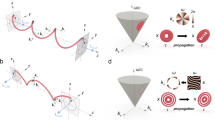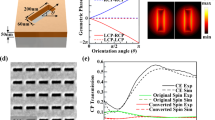Abstract
Today, it is well known that light possesses a linear momentum that is along the propagation direction. Besides, scientists also discovered that light can possess an angular momentum, a spin angular momentum (SAM) associated with circular polarization and an orbital angular momentum (OAM) owing to the azimuthally dependent phase. Even though such angular momenta are longitudinal in general, an SAM transverse to the propagation direction has opened up a variety of key applications1. In contrast, investigations of the transverse OAM are rare due to its complex nature. Here, we demonstrate a three-dimensional wave packet that is a spatiotemporal (ST) optical vortex with a controllable purely transverse OAM. Contrary to the transverse SAM, the magnitude of the transverse OAM carried by the ST vortex is scalable to a larger value by simple adjustments. Since the ST vortex carries a controllable OAM uniquely in the transverse dimension, it has strong potential for novel applications that may not be possible otherwise. The scheme reported here can be readily adapted for other spectral regimes and different wave fields, opening opportunities for the study and applications of ST vortices in a wide range of areas.
This is a preview of subscription content, access via your institution
Access options
Access Nature and 54 other Nature Portfolio journals
Get Nature+, our best-value online-access subscription
$29.99 / 30 days
cancel any time
Subscribe to this journal
Receive 12 print issues and online access
$209.00 per year
only $17.42 per issue
Buy this article
- Purchase on Springer Link
- Instant access to full article PDF
Prices may be subject to local taxes which are calculated during checkout




Similar content being viewed by others
Data availability
All data of this study are available from the corresponding authors upon reasonable request.
Code availability
All codes used for data analysis and simulations are available from the corresponding authors upon reasonable request.
References
Ariello, A., Banzer, P., Neugebauer, M. & Leuchs, G. From transverse angular momentum to photonic wheels. Nat. Photon. 9, 789–795 (2015).
Poynting, J. H. The wave motion of a revolving shaft, and a suggestion as to the angular momentum in a beam of circularly polarised light. Proc. R. Soc. Lond. A 82, 560–567 (1909).
Richards, B. & Wolf, E. Electromagnetic diffraction in optical systems. II. Structure of the image field in an aplanatic system. Proc. R. Soc. Lond. A 253, 358–379 (1959).
Bliokh, K. Y. & Nori, F. Transverse spin of a surface polariton. Phys. Rev. A 85, 061801 (2012).
Bliokh, K. Y., Rodríguez-Fortuño, F. J., Nori, F. & Zayats, A. V. Spin–orbit interactions of light. Nat. Photon. 9, 796–808 (2015).
Rodríguez-Herrera, O. G., Lara, D., Bliokh, K. Y., Ostrovskaya, E. A. & Dainty, C. Optical nanoprobing via spin-orbit interaction of light. Phys. Rev. Lett. 104, 253601 (2010).
Zhao, Y., Edgar, J. S., Jeffries, G. D., McGloin, D. & Chiu, D. T. Spin-to-orbital angular momentum conversion in a strongly focused optical beam. Phys. Rev. Lett. 99, 073901 (2007).
Pichler, H., Ramos, T., Daley, A. J. & Zoller, P. Quantum optics of chiral spin networks. Phys. Rev. A 91, 042116 (2015).
Cardano, F. & Marrucci, L. Spin–orbit photonics. Nat. Photon. 9, 776–778 (2015).
Neugebauer, M., Bauer, T., Aiello, A. & Banzer, P. Measuring the transverse spin density of light. Phys. Rev. Lett. 114, 063901 (2015).
Allen, L., Beijersbergen, M. W., Spreeuw, R. J. C. & Woerdman, J. P. Orbital angular-momentum of light and the transformation of Laguerre–Gaussian laser modes. Phys. Rev. A 45, 8185–8189 (1992).
Coullet, P., Gil, G. & Rocca, F. Optical vortices. Opt. Commun. 73, 403–408 (1989).
He, H., Friese, M., Heckenberg, N. R. & Rubinsztein-Dunlop, H. Direct observation of transfer of angular momentum to absorptive particles from a laser beam with a phase singularity. Phys. Rev. Lett. 75, 826–829 (1995).
Yan, L. et al. Q-plate enabled spectrally diverse orbital-angular-momentum conversion for stimulated emission depletion microscopy. Optica 2, 900–903 (2015).
Djordjevic, I. B. & Arabaci, M. LDPC-coded orbital angular momentum (OAM) modulation for free-space optical communication. Opt. Express 18, 24722–24728 (2010).
Sukhorukov, A. P. & Yangirova, V. V. Spatio-temporal vortices: properties, generation and recording. Proc. SPIE 5949, 594906 (2005).
Bliokh, K. Y. & Nori, F. Spatiotemporal vortex beams and angular momentum. Phys. Rev. A 86, 033824 (2012).
Jhajj, N. et al. Spatiotemporal optical vortices. Phys. Rev. X 6, 031037 (2016).
Rego, L. et al. Generation of extreme-ultraviolet beams with time-varying orbital angular momentum. Science 364, eaaw9486 (2019).
Cornacchio, J. V. & Soni, R. P. On a relation between two-dimensional Fourier integrals and series of Hankel transforms. J. Res. Natl Bureau Standards B 69B, 173–174 (1965).
Weiner, A. M. Femtosecond pulse shaping using spatial light modulators. Rev. Sci. Instrument. 71, 1929–1960 (2000).
Dallaire, M., McCarthy, N. & Piché, M. Spatiotemporal Bessel beams: theory and experiments. Opt. Express 17, 18148–18164 (2009).
Kondakci, H. K. & Abouraddy, A. F. Diffraction-free space-time light sheets. Nat. Photon. 11, 733–740 (2017).
Li, Y. & Lewellen, J. W. Generating a quasiellipsoidal electron beam by 3D laser-pulse shaping. Phys. Rev. Lett. 100, 074801 (2008).
Li, H., Bazarov, I. V., Dunham, B. M. & Wise, F. W. Three-dimensional laser pulse intensity diagnostic for photoinjectors. Phys. Rev. ST Accel. Beams 14, 112802 (2011).
Nye, J. F. & Berry, M. V. Dislocations in wave trains. Proc. R. Soc. Lond. A 336, 165–190 (1974).
Hancock, S. W., Zahedpour, S., Goffin, A. & Milchberg, H. M. Free-space propagation of spatiotemporal optical vortices. Optica 6, 1547–1553 (2019).
Author information
Authors and Affiliations
Contributions
A.C. proposed the original idea and performed all experiments and some theoretical analysis. C.W. performed all theoretical analysis and some experiments. J.C. contributed in developing the measurement method. Q.Z. guided the theoretical analysis and supervised the project. All authors contributed to writing the manuscript.
Corresponding authors
Ethics declarations
Competing interests
The authors declare no competing interests.
Additional information
Publisher’s note Springer Nature remains neutral with regard to jurisdictional claims in published maps and institutional affiliations.
Supplementary information
Supplementary Information
Supplementary Figs. 1–5, captions for videos 1–7 and refs. 1–9.
Supplementary Video 1
Experimental phase pattern movie as the reference pulse is scanned on the ST vortex with l = 1. The first two slides are beam profiles of the ST vortex and reference beam, respectively. The scanning step size is ~33 fs. The reference pulse duration is ~90 fs.
Supplementary Video 2
Theoretical phase pattern movie as the reference pulse is scanned on the ST vortex with l = 1.
Supplementary Video 3
Experimental phase pattern movie as the reference pulse is scanned on the ST vortex with l = −1. The scanning step size is ~33 fs.
Supplementary Video 4
Experimental phase pattern movie as the reference pulse is scanned on the ST vortex with l = 2. The scanning step size is ~33 fs.
Supplementary Video 5
Theoretical phase pattern movie as the reference pulse is scanned on the ST vortex with l = 2.
Supplementary Video 6
Experimental 3D iso-intensity movie of the ST vortex with l = 1.
Supplementary Video 7
Experimental 3D iso-intensity movie of the ST vortex with l = 2.
Rights and permissions
About this article
Cite this article
Chong, A., Wan, C., Chen, J. et al. Generation of spatiotemporal optical vortices with controllable transverse orbital angular momentum. Nat. Photonics 14, 350–354 (2020). https://doi.org/10.1038/s41566-020-0587-z
Received:
Accepted:
Published:
Issue Date:
DOI: https://doi.org/10.1038/s41566-020-0587-z
This article is cited by
-
Observation of spatiotemporal optical vortices enabled by symmetry-breaking slanted nanograting
Nature Communications (2024)
-
Orbital angular momentum lasers
Nature Reviews Physics (2024)
-
Spatiotemporal optical vortex reconnections of multi-vortices
Scientific Reports (2024)
-
Direct space–time manipulation mechanism for spatio-temporal coupling of ultrafast light field
Nature Communications (2024)
-
Integrated vortex soliton microcombs
Nature Photonics (2024)



